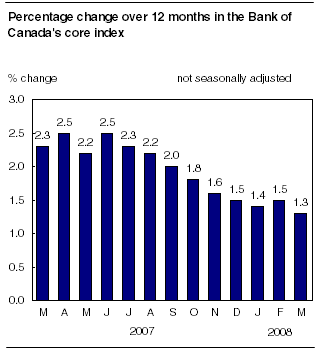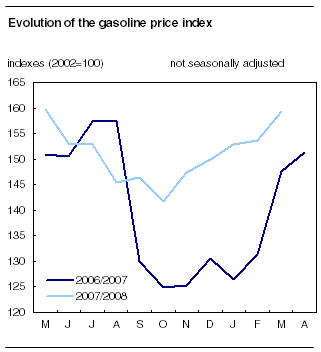
| Thursday, April 17, 2008 Released at 7:00 a.m. Eastern time in The Daily |
 Troubleshooting PDFs |
Consumer prices rose 1.4% on average in the 12 months to March 2008, the fourth consecutive month in which the rate of growth has decelerated. This was the slowest rate of growth since January 2007.

The main upward factor in March was mortgage interest cost, which rose 8.3%, while gasoline prices were the second most significant contributor.
Prices at the pump rose by 7.9% between March 2007 and March 2008, less than half the rate of growth of 17.1% posted the previous month. If pump prices are excluded, the all-items Consumer Price Index (CPI) increased 1.0% in the 12 months to March 2008.
The 12-month change in the Bank of Canada's core index, which is used to monitor the inflation control target, rose 1.3% in March, down from the 1.5% increase in February. This deceleration was mostly attributable to lower prices for automotive vehicles.
Consumer prices rose 0.4% between February and March 2008, the same rate as in the preceding period. The core index increased by 0.2% between February and March 2008, a slowdown compared with the 0.5% increase during the previous period.

12-month change: Reduced upward pressure from gasoline prices
Gasoline prices exerted less upward pressure on the all-items index than they did in February. Pump prices increased 7.9% between March 2007 and March 2008, compared with the 17.1% gain in February.
This slowdown reflected the fact that gasoline prices in March this year increased at a slower pace than they did in March last year. In spite of its relative loss of speed, pump prices were the second biggest contributor to the 12-month increase in the all-items CPI.
The main contributor to the upward pressure on the all-items index was mortgage interest cost, which rose 8.3% in March compared with the same month a year earlier, slightly faster than the 8.1% posted in February. This acceleration was due more to the slower monthly growth in this index in the same period last year than to any recent acceleration. The upswing in prices of new housing in March continued to put more upward pressure on mortgage interest cost than the change in interest rates.

The price of fuel oil and other fuels surged 29.6% in the 12 months to March 2008. This was the steepest jump in prices since September 2005, when hurricanes Katrina and Rita provoked a sharp spike in prices. The biggest increases in fuel oil and other fuels occurred in provinces east of Ontario, where prices rose between 27.6% and 37.0%.
Homeowners' replacement cost, which represents the cost of maintaining a housing structure, was up 4.8% between March 2007 and March 2008, the same increase as in February. New housing costs were up in all parts of the country compared with the same period last year.
Homeowners' replacement cost surged 46.7% in Saskatchewan, the fastest pace among the provinces. With the fast growing natural resources sector, the Saskatchewan real estate market appears to be experiencing the strongest growth in the country.
The price of bakery products increased 9.0% in the 12 months to March 2008, as world wheat prices appreciated considerably. Reports indicated that the price for No. 1 grade wheat more than doubled between March 2007 and March 2008, the sharpest gain in 25 years.
The main factor mitigating these upward pressures was a 7.1% slide in prices for purchasing and leasing vehicles, on the heels of a 6.8% drop in February. March's decline was linked to the increase of incentives on most models and to relatively low manufacturer's suggested retail prices compared with March 2007.

Prices for computer equipment and supplies fell 14.9% in March, following a 15.4% decline in February, in the wake of lower prices for laptop computers. The decline in prices for central processing units for desktop computers was less in March than in February. The downward movement was consistent with the long-term trend for this index, which reflects in part technological advances and competition in this sector.
The price of fresh vegetables fell 17.8% in March 2008 compared with March 2007, the largest decrease in 12 years. Vegetable prices were relatively higher in March 2007 because of a frost in California. The appreciation of the Canadian dollar between March 2007 and March 2008 could also have helped to lower prices of imported vegetables.
Prices for fresh fruit slumped a substantial 11.3% between March 2007 and March 2008, mainly in response to lower prices for citrus fruits, grapes and cantaloupes.
Prices for women's clothing fell 4.3% in the 12 months to March 2008, a faster decline than the 3.0% decrease posted the previous month.
Ontario consumers enjoy slowest increase in prices
Consumers in Ontario enjoyed the slowest increase in prices in March among the provinces. Prices on average rose only 0.8% between March 2007 and March 2008 in Ontario, a much slower growth than the 1.5% increase in February. In Alberta, consumers paid 2.9% more on average in March this year than they did the same month a year earlier, compared with 3.5% in February.
This deceleration of consumer prices in Ontario and Alberta reflects a slower rise in gasoline prices in March 2008 compared with March 2007.
Consumers in Saskatchewan faced the highest 12-month increase (+3.2%). This increase was mainly supported by the rise in homeowners' cost and gasoline prices.
Monthly change: Rise in all-items index sustained by higher gasoline prices
Consumer prices rose by 0.4% between February and March 2008, unchanged from the rate of growth posted a month earlier.
The main factor in the monthly increase was a 3.6% jump in gasoline prices, which coincided with the result of gains in the price of crude oil. The price of gasoline surged 12.4% in this same period last year.
Higher prices for women's clothing (+3.0%) also contributed to the rise in consumer prices, albeit to a lesser extent. This upward movement occurred as new spring collections hit stores.
Consumers paid 8.6% more for fuel oil and other fuels in March than in February. This increase reflects, to some extent, lower inventories at the end of winter as well as higher crude oil prices.
Mortgage interest costs rose 0.6% between February and March. This was a slowdown from the 0.8% increase recorded the previous month, the result of a decline in rates at which mortgages were renewed and initiated.
Amongst the factors dampening the monthly rise in prices were a 0.8% decline in prices for the purchase and leasing of passenger vehicles and a 2.8% decline in the cost of traveller accommodation.
The downward movement in vehicle prices was due to higher incentives offered on some models by manufacturers.
Available on CANSIM: tables 326-0009, 326-0012, 326-0015 and 326-0020 to 326-0022.
Definitions, data sources and methods: survey number 2301.
More information about the concepts and use of the CPI are also available online in Your Guide to the Consumer Price Index (62-557-XIB, free) from the Publications module of our website.
The March 2008 issue of the Consumer Price Index, Vol. 87, no. 3 (62-001-XWE, free) is now available from the Publications module of our website. A paper copy is also available (62-001-XPE, $12/$111). A more detailed analysis of the CPI is available in this publication.
The April Consumer Price Index will be released on May 21.
For more information or to enquire about the concepts, methods or data quality of this release, call Client Services (toll-free 1-866-230-2248; 613-951-9606; fax: 613-951-1539; prices-prix@statcan.ca), Prices Division.
| Consumer Price Index and major components | ||||||||||||
|---|---|---|---|---|---|---|---|---|---|---|---|---|
|
(2002=100) | ||||||||||||
| Relative importance1 | March 2008 | February 2008 | March 2007 | February to March 2008 | March 2007 to March 2008 | |||||||
| All-items | ||||||||||||
| Food | ||||||||||||
| Shelter | ||||||||||||
| Household operations and furnishings | ||||||||||||
| Clothing and footwear | ||||||||||||
| Transportation | ||||||||||||
| Health and personal care | ||||||||||||
| Recreation, education and reading | ||||||||||||
| Alcoholic beverages and tobacco products | ||||||||||||
| All-items (1992=100) | ||||||||||||
| Special aggregates | ||||||||||||
| Goods | ||||||||||||
| Services | ||||||||||||
| All-items excluding food and energy | ||||||||||||
| Energy | ||||||||||||
| Core CPI3 | ||||||||||||
| ||||||||||||
| Consumer Price Index by province, and for Whitehorse, Yellowknife and Iqaluit1 | |||||||||
|---|---|---|---|---|---|---|---|---|---|
|
(2002=100) | |||||||||
| March 2008 | February 2008 | March 2007 | February to March 2008 | March 2007 to March 2008 | |||||
| Newfoundland and Labrador | |||||||||
| Prince Edward Island | |||||||||
| Nova Scotia | |||||||||
| New Brunswick | |||||||||
| Quebec | |||||||||
| Ontario | |||||||||
| Manitoba | |||||||||
| Saskatchewan | |||||||||
| Alberta | |||||||||
| British Columbia | |||||||||
| Whitehorse | |||||||||
| Yellowknife2 | |||||||||
| Iqaluit (Dec. 2002=100) | |||||||||
| |||||||||
Navigation and search
Note: This page contains several navigation menus. To enhance accessibility, most of these menus and the site search box are grouped in this section.
To find out more about accessibility features on our site, read our accessibility page.

